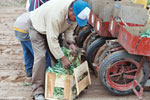Spraying, Tree Care
Orchard Spraying Facts: Orchard spraying falls into two classes:
- tree spraying for disease and pest control, nutrition, growth regulation, and chemical thinning
- ground spraying for weed control, including discouraging mice, insects and disease by keeping vegetation away from the tree trunk; also not traumatizing tree roots as mechanical methods of weeding does
Major components:
- Depending on the operation, a farmworker may do:
- spraying
- assist with the mixing, application or storage
- simply work in where spraying has recently taken place
- Regardless of which role the farmworker plays, all of activities are legally regulated:
- Chemical application
- Must be certified as an applicator
- Must be fit tested with a respirator
- Must wear other personal protective equipment specific instruction to handlers
- Trained about label information safe operation of application equipment
- Chemical mixing, handling or storage
- Should only be performed by worker who is a certified applicator
- All chemicals must be clearly labeled, dated
- Chemicals can only be disposed of at designated waste sites
- Working on a farm where chemicals are applied
- Must receive EPA Worker Protection Standard training, which includes how to recognize a newly sprayed area
- How to minimize personal exposure
- Understanding of worker rights with regard to protection
- First aid and emergency response instructions
Clinical Key Point: Understanding the extent of adherence to regulations at the worker’s farm may help determine whether symptoms may be related to pesticide exposure.
 Chemical Contact
Chemical Contact Muscle Strain
Muscle Strain